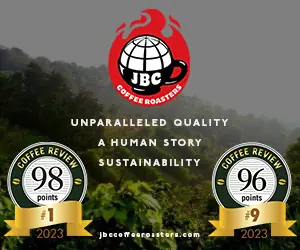For those interested in exploring single-origin coffees as espressos, here is an overview of the better-known coffees of the world from an expresso perspective.
Powerfully Acidy Coffees. The best-known are Kenyas, Strictly Hard Bean Costa Ricas and Guatemalas, Yemen Mochas, and the better Colombias. These are all high-grown, dense-bean coffees that display bright, acidy notes in nut-brown roasts and turn intensely bittersweet in dark-brown styles. They may be a bit overwhelming as a straight espresso but will carry through almost any amount of milk and make excellent highlight coffees in espresso blends. Unlike Kenya and the Latin-America coffees, Yemen coffees are dry-processed or dried inside the fruit, which may account for the way they often round out in a darker roast better than many Kenyas or high-grown Central Americas. Straight Yemen brought to a moderately dark roast can make a superb espresso.
Classic Coffees with Gentler Profiles. Most Carribean coffees (Puerto Rico, Jamaica Blue Mountain, Dominican, Haiti, etc), Mexicos, El Salvadors, Nicaraguas, Panamas, Perus, all are wet-processed coffees with a bright but gentle acidity usually easily tamed by dark-roasting. The sweeter versions of these coffees will make a pleasant espresso, relatively light-bodied but round and lively. Some Perus produce a particularly agreeable demitasse.
Brazil Coffees. The finest Brazil coffees — low-acid, sweet, round, full-bodied — are espresso treasures. These coffees, which come into their own only when roasted and brewed as espresso, are grown on a handful of medium-to-large Brazilian farms, come from trees of the traditional Bourbon variety, and are dry or "natural" processed. They must be roasted tactfully to preserve their sweetness and will not tolerate extremely dark roast styles. But if everything is right these dry-processed Brazil Bourbons are among the most exquisite of espresso-inclined origins.
Hawaiian Coffees. America’s obsession with its home-grown coffee leads me to give it its own category. Hawaii Kona, one of the world’s most expensive coffees, is hardly ever presented as espresso because its high-priced subtleties are lost in a darker roast. However, you will find Konas dark-roasted simply because the people who roast them don’t know any better. If you do try one of these inadvertently dark-roasted Konas as espresso, and if it hasn’t been destroyed in the roasting, it will yield a pleasant if light-bodied demitasse. On the other hand, some of the very best Konas are rather acidy coffees that make a powerful, bittersweet espresso along high-grown Costa-Rica lines. Coffees from large farms outside the Kona district, on the islands of Kauai and Molokai are less expensive, available directly from the growers in dark-roast styles, and can make interesting espressos if the roast is handled carefully.
Indonesia and India Coffees. Coffees from the gigantic Indonesian islands of Sumatra and Sulawesi (old name Celebes) can make splendid espresso: full bodied, sweet yet pungent, complex. The problem is finding good Sumatras and Sulawesis. Along with the rich, complex, sweet versions, many cheap, harsh-tasting Sumatras and Sulawesis find their way into North America. But there is no doubt that the best and sweetest figure with the finest dry-processed Brazils as the most desirable of espresso origins.
Wet-processed coffees from Java and Papua New Guinea produce sweet but lighter-bodied espressos than the best Sumatras and Sulawesis. India coffees are typically low-toned and display sweetness and body but may come off as a bit inert.
Ethiopias and other Africa Coffees. Kenya coffees are in a class of their own: powerfully acidy, deeply resonant, alive with wine and (on occasion) berry notes, and wonderfully consistent. Typically, however, they are too acidy or (in a dark roast) too pungent for espresso brewing on their own. Ethiopia coffees tend to be fragrant, relatively light bodied, and can make very interesting and elegantly nuanced espresso. The famous and distinctive Ethiopia Yirgacheffe, with its extraordinary floral perfumes, may be a touch too light-bodied for espresso, but can add wonderfully tantalizing high notes to a blend. Other African coffees, like Zimbabwes and Malawis, are wine- or fruit-toned coffees that make interesting but also relatively light-bodied espressos.
Robustas. The best coffees from the Coffea canephora or Robusta species imported into the United States are grown in the Ivory Coast, Thailand, and India. You will not find them for sale as single-origin coffees, however. If you are a home roaster and you manage to turn some up as green coffee and roast them, you will discover that they are heavy, monotoned, and inert. Some professional blenders condemn them. Others claim that they add resonance to an espresso blend, forming an unheard but amplifying sounding board for more assertive notes.
Aged and Monsooned Coffees. These specially handled coffees are usually too heavy and monotoned on their own, but in small quantities can add weight and complexity to blends.










